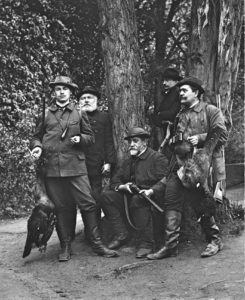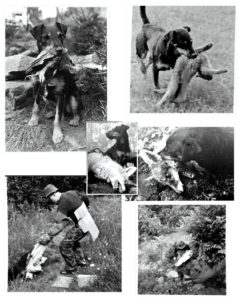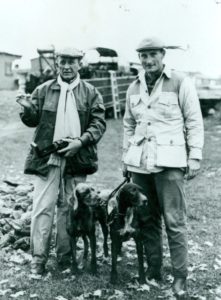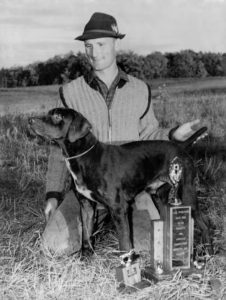The following is a biography of Bodo Winterhelt. It has been provided by Paul and Joan von Hardnberg who graciously compiled many of Bodo’s life adventures. The interviews took place over a series of phone calls. The original article was published prior to Bodo’s passing. Copyright is that of the authors. Please enjoy. (Please view photos at bottom of article).
Sigbot ‘Bodo’ Winterhelt is a name familiar to most NAVHDA members. They are aware he played a significant role in the formation of the organization. However few members today, especially the younger or newer participants, have had the opportunity to meet Bodo or know the events that contributed to his commitment to dogs and hunting and the promotion of the versatile breeds in North America.
Bodo’s family and acquaintances in Germany and his early experiences training, testing and breeding various types of hunting dogs shaped his philosophy for what would become a lifelong career with dogs. Or it may have been in his genes. Family members were avid hunters and outdoorsmen, and some were active members of dog organizations.
Bodo and his brother Volkmar were born into a prosperous family business, still operating today, and could have followed into the stone construction firm started by their grandfather, Casper Winterhelt. However, for Bodo it was always dogs and for Volkmar it was always horses. The Winterhelt home, now a youth hostel in Miltenberg, Germany on the Main River, was designed and built by their architect father, Oscar. Bodo lived there as a young child until his father moved the family to Berlin. Bodo’s uncle continued to live in the home.
An old photograph of the hunters in a forest is a family portrait. Bodo’s uncle, on the left, his grandfather, seated, and his father, behind the tree with no gun, seem to be returning from a successful hunt. The turkey sized birds are Auerhuhn (male Auerhahn, female Auerhenne), the largest members of the grouse family. Capercaillie is the English name. Only the males could be hunted. These mountain or wood grouse are native to the open coniferous forests of Northern Europe and have become increasingly rare, mostly due to habitat loss. Even at the end of the nineteenth century they were primarily hunted only by wealthy sportsmen. As a youngster, Bodo had two taxidermy Auerhahn in his room.
According to Bodo, during mating season in the early morning darkness, a male bird would perch in the evergreen trees in display mode with his head stretched high and call to the smaller females on the ground (half the weight and size of the males). Hunters without dogs would stealthily approach while the male was gazing upward and vocalizing (about five seconds at a time) until the bird was within sight and shooting range. Combination guns were popular, but only a rifle barrel, not a shotgun barrel, was typically used on an Auerhahn.
A combination gun is a break-action firearm with at least two barrels, a rifle barrel and a shotgun barrel. There are various combinations of over and under or side by side configurations. Their advantage is that one gun can be used for a wide variety of game that might be encountered, although the gun is relatively heavy. Bodo’s grandfather is holding a ‘drilling’ (three barrels) with the rifle barrel below two shotgun barrels. Closer inspection of this gun shows a mounting platform for a quick mountable scope, not attached in the photo.
Bodo’s uncle Dr. jur. Erich Winterhelt (Juris Doctor or Doctor of Law) was the first Vorsitzender (Chairman or President) from 1920 – 1945 of the Main-Spessart-Ecke district of Germany Deutsche Drahthaar Club. This club is still in existence with over 200 members, and represents the largest area in Germany except for the Berlin area. His uncle was a big name in German Wirehairs who bred, trained and successfully handled dogs to first prize levels. A photo shows his uncle with dog, gun and binoculars.
The Winterhelt family doctor (or house doctor, according to Bodo) was Dr. Paul Kleeman. When Bodo was a youngster, Dr. Kleeman persuaded his parents to let Bodo follow his interest and enthusiasm for dogs. Bodo was tired of visiting museums and the seashore and instead wanted to explore a nearby kennel establishment and investigate field tests. Dr. Kleeman was President of the Berlin chapter of Klub Kurzhaar for many years. He was a knowledgeable authority and wrote extensively about the early development of the German Shorthair breed. The Kurzhaar Klub honored his service by naming their most exacting test after him. The requirements to participate in the Kleeman test are stringent and difficult, taking several years.
In spite of the Winterhelt family’s culture of hunting and dogs, Bodo did not have a personal dog until he was thirteen years old. That was when his father, whose hobby was antiques, finally granted him permission to have a dog in the house, and Bodo obtained from the neighboring Löns family a female Hunting Terrier – a Jagdterrier, Gefa. His dog ownership was almost short-lived when the pup destroyed one of Oscar’s favorite antiques – a chair that had once belonged to Napoleon Bonaparte!
That crisis was eventually resolved and soon Bodo became the youngest handler in Germany to run and prize in a Utility Test. The test, for dogs over two years of age, was held on October 24 & 25, 1942 near Hanover, Germany. Fifteen dogs were entered and handler Herr Sigbot ‘Bodo’ Winterhelt (DOB: 5/21/1926) was 16 years old. The dog he entered was his first dog, the three year old female Jagdterrier, named Gefa aus dem Lönsstamm. Gefa received a prize 3A.
The 1942 test consisted of work under the ground (on fox or badger) and work above the ground (on small size fur or feather). Specifically, under the ground evaluation included: sharpness, stamina, loud when following, loud on stopped animal, searching under the ground, and dragging fox or badger out of hole dead or alive. Test work for above the ground evaluation included: nose, search, loud (sight or track), blood tracking on long leash, retrieving feather or fur (small size, e.g., rabbit), water work (with and without duck), retrieving from deep water (swimming depth), remaining (with and without object), walk on leash, behavior on shot, and overall obedience.
Gefa (whelped 8/17/39, ZB #1972) was bred by Edmund Löns, the famous Munsterlander advocate and Bodo’s future father-in-law. Normally three judges were required for testing, but during the war years the rules were relaxed to permit a test with two judges. Underground tests were run with released live prey, usually a fox or a badger and run within a fenced area to contain the fox or badger and also to provide privacy for the participants. The underground concrete tunnels were constructed with access covers, which included feather indicators so the progress of the dogs and prey could be observed and to facilitate their retrieval. Badgers were seldom dragged out by the dogs since the badger is so strong, aggressive and heavy. However, badgers were preferred since their fur could be then sold for manufacture of shaving brushes, which were and still are popular with the British.
Sharpness can be an issue today since wild game must be used and wild predators are not always easy to obtain. Thus dogs can now get a first prize without killing, but will not receive a killing sign ‘1.’
A year after Bodo ran Gefa in this utility test, he was fox hunting with her and lost her. She began a trail on a fox, got out of hearing range and didn’t return. He searched for her, missing three days of school. When his mother questioned him and found out what happened, she got him another Jagdterrier before his father could object. Looking back, Bodo thinks that someone shot Gefa since she had never previously failed to return to him. Perhaps someone thought that poaching was in progress or that she was illegally chasing game, since she did not look like the usual larger hunting dog.
Hunting lands in Germany were typically leased, nine years for small game, 12 years for big game. The lessee had virtual control and ‘police power’ over the land and those who hunted on it. A hunter needed to carry written permission or be hunting with the lessee to be legal. However, Bodo said that those who hunted with a Drahthaar had an inherent advantage because that breed had a reputation for being aggressive and that could make a challenger ignore or back down from initiating a confrontation. He said that people had more fear of dogs with fierce reputations such as German Shepherds than any intimidation that a policeman could muster.
The war years were bad for Bodo’s family. His father’s priceless antique collection was destroyed when their Berlin home was bombed. His brother Volkmar, an officer in the German army, was captured by the advancing Allies and spent five grueling years in a Russian POW camp (A camp where only 9,000 out of 23,000 prisoners survived.). Bodo, a teenager, was conscripted into the military towards the end of the war and fortunately or unfortunately ended up in an English hospital with a critical stomach wound. He was released from the hospital to recuperate in the home of Edmund Löns, the distant neighbor who had bred Gefa. Bodo claims that it was here that he gained knowledge about breeding, training and handling of dogs. Here also he came to know his future wife.
At the end of WW II food was in short supply in Germany. Bodo was able to use dogs to hunt and retrieve game to provide needed food. During the early days of the Allied occupation, Germans were not permitted to possess weapons, so for a short time until he was allowed to have a gun, Bodo used a spear to hunt wild boar. He emphasized that dogs had to be ‘Vielseitig,’ the German word meaning versatile.
Bodo’s father-in-law, Edmund Löns, was one of the pioneers credited for reviving Small Munsterlanders in the early 1900s. These dogs were used in northern Germany in the late 1800s to help ‘bread hunters’ recover wounded game, but as recreational hunting replaced subsistence hunting because of cultural and wildlife changes, few Small Munsterlanders remained. Edmund discovered and obtained two lines, one fine boned, agile, lively and intelligent, known for their ‘track sound’ on the trail; the other line being slow in search, of strong build, and excellent in use of nose. Löns called them Heidewachtel or Heathland quail dog. When a club was formed in 1912, the Small Munsterlander name was chosen. (See www.jaegerbakken.com/history1.htm). Following WW II, breeding dogs was a challenge for breeders such as Edmund and Bodo since many records had been destroyed.
Hermann Löns (1866 – 1914), brother to Edmund, was a famous journalist, a writer known also for his poetry and folksongs. He was a hunter, natural historian and conservationist, the ‘Ernest Hemingway of Germany.’ During WW I at the age of 48 he enlisted in the German Army; three weeks later he was killed while on patrol. In 2006 a bronze statue of him with dog, gun and binoculars was erected in Walsrode, Germany. Binoculars or a monocular, along with a combination gun were essential gear for German hunters dating from the late 1800’s. (Find Hermann Löns on Wikipedia).
After recovering from his wounds Bodo became the youngest judge (19 years old) for Hunting Terriers and Pointing Dogs in Germany and the first trainer of Small Munsterlanders to win in Utility Tests. These Munsterlanders were Lilo Löns #7611 – Prize 2 0.S. (without sharpness), bred and owned by Bodo, and Alux vom Eggetal #7612 – Prize 3 0.S. The Small Munsterlanders’ greatest difficulty in the UT was the requirement to jump over a 2 foot hurdle with a dead fox which was nearly the same weight as the dog.
Bodo eventually departed from training and breeding Small Munsterlanders with Edmund Löns to pursue his interest in Pudelpointers. Distemper was claiming the litters of their Small Munsterlanders and no vaccines were then available. Bodo had a Pudelpointer he was training and that dog seemed to have a natural immunity to distemper, even after licking the eyes of sick dogs. At that time Bodo thought that the problem was with the Munsterlanders. He later realized that Edmund’s old kennels were contaminated and the source of the disease. He parted ways with Edmund since he “had to make a living.” Bodo also liked the Pudelpointer as a breed. That was the beginning of his life-long attachment to the Pudelpointer.
In the 1950’s Bodo began a lasting friendship with Hannes Liederley, a well known wildlife artist, a painter and sculptor (1912 -1999). The photo collage shows a Hunting Terrier named Winterhelle’s Negus, belonging to Liederley. Negus is shown with a duck and also with a fox illustrating the relative size of the dog and the fox. Other photos show Negus attacking Bodo on command with Bodo wearing improvised arm and back protection. Bodo said “These buggers have sharp teeth and can really bite, so they make good house protection dogs.” The Hunting Terrier is still being used today in thick cover in Germany to hunt Russian Boar, now numbering 1.6 million; there is a bounty for taking these animals. Bodo has a photo of Liederley’s sculpture of a Boar and three Terriers which demonstrates the size discrepancy between the large Boar and the dogs. In addition, Bodo owns several original Liederley paintings.
In 1954 Bodo and his brother Volkmar emigrated from Germany to Canada, each seeking better opportunities to advance in their chosen vocations. Volkmar was active in horsemanship, competing in dressage events. Bodo’s early employment ran the gamut from cutting tobacco leaves or working as a lumberjack to being hired as a veterinary assistant by Dr. Allen Seecord. It was with the help of Dr. Seecord that he finally got the position of manager of an exclusive private hunting club, the Nicholson Island Club located on a 500 acre island on Lake Ontario.
During this time Bodo met Douglas Hume. They became good friends and worked together to translate the rules of the German hunting dog tests into English. Bodo had received permission from the German Pudelpointer Club to bring the breed to North America, and in 1956 he imported Cati v. Waldorf and began to compete in field trials. Bodo and Doug Hume eventually established the basic philosophy for the testing of versatile hunting dogs and the idea for NAVHDA began to take shape.
The first tentative versatile rules were established in 1960 and an organization named the All Purpose Gun Dog Association was formed. In 1961 this group held its first and only trial, attracting fourteen entries from Canada and the US. The winner of the event was Bodo’s dog, Winterhelle’s Komet, offspring of Cati. Komet’s impressive performance was acclaimed by the press of both countries. Bodo believes that Komet did more to promote the versatile concept than any other dog, and Bodo received broad acceptance to classify certain breeds as versatile. These were primarily the continental breeds including: Brittany, German Shorthaired and Wirehaired Pointers, German Roughhaired and Longhaired Pointers, Large and Small Munsterlanders, Pudelpointers, Spinonis, Weimaraners, Wirehaired Pointing Griffons, and Vizslas.
Bodo has the longest membership in the Pudelpointer club world-wide. In the early 1960’s Bing Crosby was a frequent visitor at the private Nicholson Island preserve and already owned one of Bodo’s Pudelpointers. He was so impressed by Bodo’s dog, Paloma, that he offered a blank check to purchase her as well. However, since Paloma was an important part of Bodo’s Pudelpointer breeding plan, the check was returned. Later Mr. Crosby offered Bodo the position of manager of his 137,000 acre ranch in Nevada. This too was turned down, in part because Bodo could not envision living and working with dogs in the barren Nevada landscape, so different from the greenery of Germany and Canada.
In 1965 Bodo was contacted by Dr. Edward D. Bailey a young professor of Animal Behavior at Guelph University who was interested in the testing concept that Bodo was developing. In 1969 the fledging NAVHDA was established and by 1974 the now well-known book, The Training and Care of the Versatile Hunting Dog, commonly called “The Green Book,” authored by Ed and Bodo was published.
Bodo has trained various dogs for over 70 years and has trained up to 500 dogs in a given year. Assuming an average of 100 dogs per year for 60 years, Bodo has conservatively trained well over 5,000 dogs.
Yet it is not the sheer number of dogs that Bodo trained that is most significant. It is his effect on the hunting dog world as a whole. Bodo initiated the concept of cooperative, non-competitive tests in North America instead of the usual dog field trials. He brought over from Europe the idea of multiple judges who evaluated dogs according to standards, i.e., more than one dog could pass with a Prize I. He emphasized in training clinics the importance of owners doing the training of their own dogs, their hunting companions. He felt that dog tests should be as close as possible to real hunting situations. Through his efforts the term versatile dogs was introduced to North America. He is convinced that breed clubs and their strict standards tailored to each breed have improved those particular breeds.
Bodo Winterhelt had a privileged youth, but then endured the horrors of a world war. He survived severe military injuries and then scores of years later, recovered from a serious stroke. He started a new life in Canada and then later in the United States. He believed that he should be a citizen of his home country; and he currently holds dual citizenship for both Canada and the US. He is comfortable in the company of successful entrepreneurs, talented artists and famous movie stars yet he can associate easily with hunters and dog lovers of every social status.
Bodo now lives in Oregon with his Pudelpointer, Winterhelle’s White Lie. He has a
depth and breadth of knowledge and experience in the dog world that few have. He has strong convictions and has dedicated his life to improving the versatile breeds of hunting dogs. Bodo’s passion for dogs has driven him to make many achievements, some we know and some we are still discovering.

Haus Winterhelt, Miltenberg, Germany – Built 1890 – View looking up from the Main River – See the Roman wall built 2000 years ago in front of the house
(note home researched on November 18, 2018 it is now Main Schlosschen, a bed and breakfast/ short stay apartments address is Burgweg 58, 63897 Miltenberg).

Portrait of Bodo’s uncle (left), Grandfather (seated with a ‘drilling’ gun) and father (standing behind tree without gun)

Dr. jur. Erich Winterhelt (Bodo’s uncle), first Vorsitzender (President) of the Main-Spessart-Ecke district Deutsche Drahthaar Club from 1920 – 1945

Gefa, Bodo’s first dog, the ‘little bad girl’ who destroyed Bodo’s father’s antique Napoleon Bonaparte chair, but did a good job in her UT

Bronze statue of Hermann Löns (The ‘Ernest Hemingway of Germany’) as a hunter, erected in 2006 in Walsrode, Germany

Winterhelle’s Negus, trained by Bodo, owned by Hannes Liederley (1954 photos)

Sculpture by Hannes Liederley of Boar and three Hunting Terriers

Bing Crosby and Bodo hunt wild pheasant. Lake Ontario, Canada 1962. Crosby’s dog is Winterhelle’s Paloma; Bodo’s, Winterhelle’s Olympia.

Bodo with Winterhelle’s Komet (1961)
